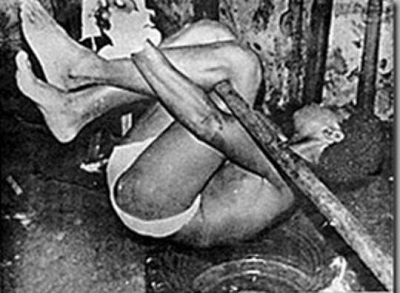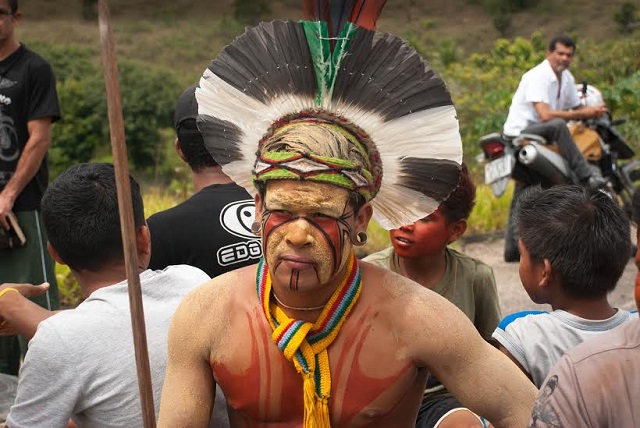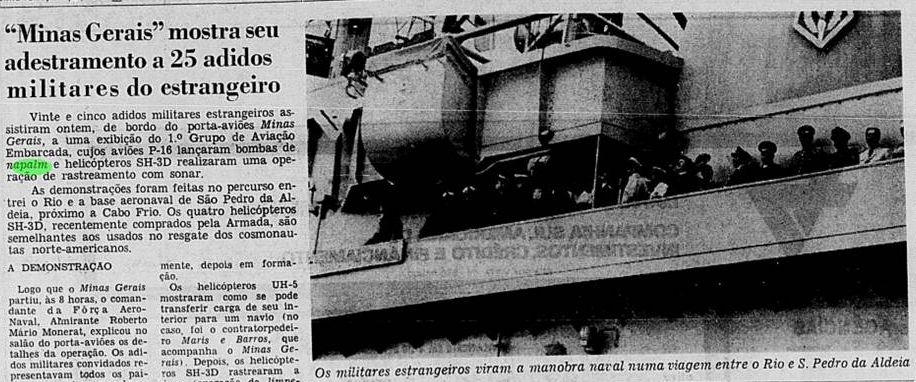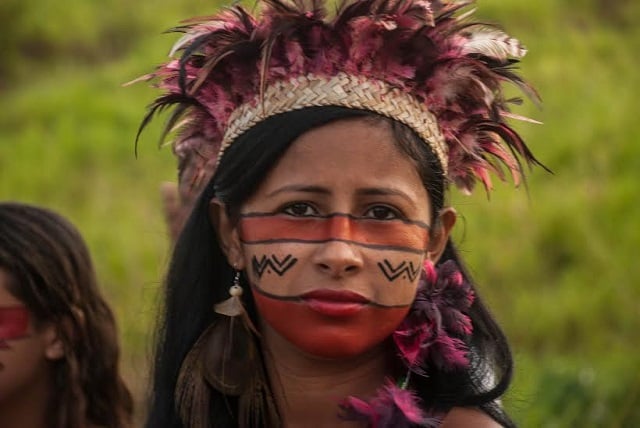
For the first time in the history of Brazil, the federal government is investigating the deaths and abuses suffered by Indigenous peoples during military dictatorship (1964-1985). The death toll may be twenty times more than previously known.
Just as in World War II and Vietnam, napalm manufactured in the US burned the bodies of hundreds of indigenous individuals in Brazil, people without an army and without weapons. The objective was to take over their lands. Indigenous peoples in this country suffered the most from the atrocities committed during the military dictatorship (1964-1985) – with the support of the United States. For the first time in Brazil’s history, the National Truth Commission, created by the federal government in 2012 in order to investigate political crimes committed by the State during the military dictatorship, gives statistics showing that the number of indigenous individuals killed could be 20 times greater than was previously officially registered by leftist militants.
Unlike other crimes committed by the State during that time period, no reparations or indemnification for the acts have been offered to indigenous people; they were not even considered victims of the military regime. “From the north to the south and from the east to the west, accusations of genocide, assassination of leaders and indigenous rights defenders, slavery, massacres, poisonings in small towns, forced displacement, secret prisons for indigenous people, the bombing of towns, torture, and denigrating treatment were registered [with the State Truth Commissions],” Marcelo Zelic, vice president of the anti-torture group Never Again – SP, one of the organizations that makes up the Indigenous Truth and Justice Commission, created in order to provide documents and information to the National Truth Commission – told Truthout during an audience with the Truth Commission of San Pablo open to journalists.
 Pau de Arara device developed during the Brazilian military dictatorship. It can also refer to a physical torture technique designed to cause severe joint and muscle pain, as well as headaches and psychological trauma. (Photo: Indigenous Truth and Justice Commission of Brazil)Guaraní leader Timoteo Popyguá is from the El Dorado community in the state of Sao Paulo. He tells of his parents and grandparents, who lived in the municipality of the Manguerinha region in southern Brazil’s Paraná state, and who were victims of the military regime. Popyguá explained to Truthout that his relatives were forcibly removed from their lands, and those who managed to stay suffered from a drastic reduction in their territories. Because these indigenous groups require “ample space” for the reproduction of their cultural life, according to him this is another form of violence that they were subjected to. “My parents were victims of abuses, chained to tree trunks. The reason was land,” he says. “There must be reparations for the loss of our land and our culture.”
Pau de Arara device developed during the Brazilian military dictatorship. It can also refer to a physical torture technique designed to cause severe joint and muscle pain, as well as headaches and psychological trauma. (Photo: Indigenous Truth and Justice Commission of Brazil)Guaraní leader Timoteo Popyguá is from the El Dorado community in the state of Sao Paulo. He tells of his parents and grandparents, who lived in the municipality of the Manguerinha region in southern Brazil’s Paraná state, and who were victims of the military regime. Popyguá explained to Truthout that his relatives were forcibly removed from their lands, and those who managed to stay suffered from a drastic reduction in their territories. Because these indigenous groups require “ample space” for the reproduction of their cultural life, according to him this is another form of violence that they were subjected to. “My parents were victims of abuses, chained to tree trunks. The reason was land,” he says. “There must be reparations for the loss of our land and our culture.”
The Commission for Amnesty – a different body that the Truth Commission – was put into place in 2001 by the Ministry of Justice with the goal of analyzing the requirements for political amnesty. Currently, their official documents count 457 victims who were either murdered or disappeared by the military. The Truth Commission determined that the total number of registered cases was 8,000 indigenous individuals, and another thousand people who belonged to political organizations who were killed between 1964 and 1985.
For the indigenous people affected by the military dictatorship, there should be reparations.
“For the indigenous people affected by the military dictatorship, there should be reparations. The same reparations that were given to the families of murder victims, the families of people from political organizations who were disappeared, and to political prisoners. Legislation should be passed for collective reparations for these people. Their lands must be demarcated, both as a sign of respect to these people and to mitigate the violence that they continue to suffer today,” argues Zelic.
Zelic warns that the numbers provided do not take into account all of the cases that occurred during the military period. Therefore they should be viewed incomplete, since the official data about indigenous populations are not well-defined, and the military alleges that many documents were destroyed. The most reliable data were obtained during field studies carried out by researchers, anthropologists and indigenous experts.
“Actually, the discussion should not center around the number of dead people, because this is a statistic that is absolutely impossible to calculate with precision, since the majority of indigenous people don’t even have a population census. What we do need to discuss is the action of the State in its development processes and how they have affected indigenous groups. These processes have taken place since 1940 and include the development policies carried out up to the present day by the State. Reparations would have to include a change in the behavior of the State,” says Zelic.
Dan Mitrione: “The Master of Torture” in Brazilian Territories
 An indigenous woman from Brazil who was cut in half by the hands of landowners. (Photo: Indigenous Truth and Justice Commission of Brazil)In the state of Minas Gerais in southeast Brazil, the National Indigenous Foundation (FUNAI) created two prisons for indigenous people, under the supervision of the military police in that state. One was Krenak, in the municipality of Resplandor, and the other was called Fazenda Guaraní, in Carmesia.
An indigenous woman from Brazil who was cut in half by the hands of landowners. (Photo: Indigenous Truth and Justice Commission of Brazil)In the state of Minas Gerais in southeast Brazil, the National Indigenous Foundation (FUNAI) created two prisons for indigenous people, under the supervision of the military police in that state. One was Krenak, in the municipality of Resplandor, and the other was called Fazenda Guaraní, in Carmesia.
The prisons were like concentration camps, where native people from across Brazil were sent if they were considered to be dangerous by the State. They were obligated to do forced labor and were placed in individual holding cells, isolated from one another. They were subjected to beatings and torture. In addition to this, there were even clandestine prisons across the country built on indigenous land.
In addition, the State created the Rural Indigenous Guard (GRI) in 1969, to assist with repressing and containing discontent in indigenous towns. They recruited indigenous individuals who were subjected to three months of training with the Battalion School for Military Police in Minas Gerais.
A document created by the Indigenous Truth and Justice Commission, titled The National Truth Commission and Indigenous Peoples: One Step Away From Omission, presents the following question: Who are the military personnel that worked with the indigenous people during those three months? The creators of the document, through a series of investigations, identified Dan Mitrione, “The Master of Torture.”
CIA agent Daniel A. Mitrione was sent to train police in Latin America in the “art” of interrogation and torture.
CIA agent Daniel A. Mitrione was sent by the United States in the 1960s to train police in Latin America. He principally worked with the police of the Brazilian dictatorship and Uruguayans in the “art” of interrogation, torture, and the repression of revolutionary social movements. Mitrione came under the Office of Public Security for the United States International Development Agency (USAID).
During his time in Brazil, Mitrione trained the military police in the state of Minas Gerais, who were responsible for building the prisons for indigenous people and for the formation of the Rural Indigenous Guard. “Marcelo Zelic found part of a film made by a German photographer, Jesko Putkamer. The clip shows a line of uniformed members of the Rural Indigenous Guard being applauded as they march by those present at the time, including military members. Two indigenous individuals hold a prisoner in a ‘pau de arara,’ (a technique used by the CIA), as evidence of the repressive techniques learned by the Indigenous Rural Guard,” says the report (watch the video here).
The document also highlights the information contained in the book The Hidden Face of Terror, by AJ Lagguth, which contextualizes the origin of the presence of Dan Mitrione in Brazil and how it was related to the creation of the Rural Indigenous Guard and the Krenak Reformatory.
“In the first part of the 1960s, the US was more convinced than ever of its technical expertise – engineers, agronomists, the police – they were all holders of vital knowledge that should have been transferred to less-developed countries in the world. In Washington, Byron Engle was in charge of organizing a team capable of training police in Asia, Africa, and especially in Latin America,” says the report from the National Indigenous Truth and Justice Commission. He adds, “That’s where Dan Mitrione comes in. The creation of the Rural Indigenous Guard is the replica of the course that he gave to the police in Minas Gerais.”
Documents discovered in an archive in Washington confirmed the participation of the United States in the military coup that the Brazilian people suffered in 1964.
In 2006, historian Carlos Fico of the Federal University of Rio de Janeiro (UFRJ), discovered documents in an archive in Washington, which confirmed the participation of the United States in the military coup that the Brazilian people suffered in 1964. One of the documents, titled “A contingency plan for Brazil,” was created with the help of Lincoln Gordon, the ambassador during the coup. The United States helped those who participated in the coup in order to put up a front against what he called “a communist intervention.” The Brazilian State Department coined the operation “Brother Sam.”
This culminated in a complaint brought forth in 1997 by a Brazilian Human Rights group called Torture, Never Again, which documented that at least 20 military members graduated from the School of the Americas (SOA) in the United States, better known as the “torture school.” The group maintained that at least two instructors from SOA were directly connected to repression and human rights abuses, including false imprisonment and torture, using methods such as the electric prod, asphyxiation, and injections of “truth serum.”
The Economic Interests of the Dictatorship
A document published by the Association of Antifascist Ex-Political Prisoners was sent to the Second International War Crimes Tribunal in 1974 in Rome and Brussels. It revealed that after the military coup in 1964, thousands of hectares of indigenous land stayed in the hands of economic groups. The document was signed by a group of anthropologists who did not reveal their identity, given the persecution they had suffered up until that time.
In 1970, the real movement to occupy the land acquired by economic groups in previous years began. It was inspired by international credit organizations, the complaints allege. The World Bank, starting in 1970, gave $40 million to finance investment in livestock farming in the country. The federal government established financial incentives – a 50 percent tax exemption on earned income and other benefits – for those who invested in the Amazon. In addition, it was in charge of the infrastructure and the creation of the Plan for National Integration (PIN) for the construction of a highway system.
“Since the expansion would eventually reach the indigenous inhabitants of the extensive region, a protocol for action was defined that the president of the FUNAI translates in the following way, in Order no.01/N from January 25, 1971: The assistance for indigenous people, which should be as complete as possible, does not attempt to and should not obstruct national development or the axes of incursion for the integration of the Amazon,” says the document.
The entire process of the construction of indigenous prisons and the ethnic concentration camps is connected to the liberation of the land for the large land-holders.
“The entire process of the construction of indigenous prisons and the ethnic concentration camps is connected to the liberation of the land for the large land-holders. The militarism arrived together with the implementation of agribusiness, along with the national and industrial integration, such as in the case of the application of Aracruz Cellulose, in the state of Holy Spirit,” Benedito Prezia, from the Indigenous Pastoral of Sao Paulo, explained to Truthout.
First Contact and Death
The complaint sent to the Second International War Crimes Tribunal in 1974 related a seemingly endless number of cases where ethnic groups in the Amazon were decimated or suffered the consequences of the Brazilian government’s development policy. It also gives details about the tactics used by the corporations and by the FUNAI in the “pacification” of the native peoples.
In 1970, for example, the first contact was established with a group of Paracañas in the river valley of Pacajás, in northern Brazil. United States Steel, a US steel monopoly, had already managed to obtain, in conjunction with the state-owned company Vale do Rio Doce, the permits to exploit the iron deposits in the area. “The interest demonstrated by US Steel in the ‘pacification’ of Paracaña is not unusual,” read the complaint. “They gave a lot of support to the expedition of the FUNAI, and a helicopter descended into an open clearing to log the forests on indigenous lands.”
 Indigenous teacher teaches the history of colonization and the history of the Brazilian military dictatorship. (Photo: Santiago Navarro F.)
Indigenous teacher teaches the history of colonization and the history of the Brazilian military dictatorship. (Photo: Santiago Navarro F.)
In the helicopter were agents from FUNAI and a company director. “When the Paracaña arrived at the meeting, there were 25 people, three of whom had the flu,” read the complaint. “Just six months after the encounter, 40 indigenous people had died of the flu.” After this first contact, other illnesses were identified in the indigenous population, such as sexually transmitted infections and tuberculosis.
Another case that is cited by the document identifies the direct action of the corporations that entered into contact with the ethnic group the Tembes, on the border of the states Pará and Maranhão. “They felt unconcerned about the advance of economic expansion, since they had the land titles in their possession,” read the document. “However, the FUNAI-backed King Ranch, a huge agriculture corporation from the United States, certifying that indigenous people did not exist in the region [this was a document demanded by the Superintendent of Development in the Amazon (SUDAM) to authorize projects favored by fiscal incentives.]” Immediately afterward, the company began to request, together with the government of Pará, the cancellation of the land titles of the Tembes people.
Zelic, in his testimony before the Truth Commission, returns to the example of another case, the extermination of the Pataxo towns in the state of Bahía, in northeast Brazil, with the objective of seizing their lands for planting huge swaths of cacao and for raising cattle. In order to get rid of indigenous people in the area, they used the intentional inoculation method to give them smallpox.
Involvement of More Corporations
According to the report The National Truth Commission and Indigenous Peoples: One Step Away From Omission, the following corporations benefitted from the military regime’s occupation of the Amazon: Swift, AndersonClayton, Volkswagen, Goodyear, Nestlé, Mitsubishi, Mappin, Bordon, Ludwig, Codeara, Camargo Correa, Bradesco, and Bamerindus.
The Use of Napalm
 Journalistic document file recorded using napalm. (Photo: Indigenous Truth and Justice Commission of Brazil)
Journalistic document file recorded using napalm. (Photo: Indigenous Truth and Justice Commission of Brazil)
The first report from the State Truth Commission of the Amazon, titled “The genocide of the Waimiri Atroari people with the law,” describes the tactic of “raids,” indigenous killing expeditions that took place at the end of the 1970s, especially in the northern states, Amazonas and Acre. “Many of the ‘raids’ included the direct participation of government officials,” according to the document.
The first report from the State Truth Commission of the Amazon describes the tactic of “raids,”
One of the tactics employed was the use of napalm. In her testimony before the Truth Commission of Sao Paulo, the reporter Memélia Moreira, who provided coverage during the military regime, wrote that genocide was perpetrated by the State against indigenous people. She also said that in one of the reports evidence was found that napalm was used in the territory of Waimiri Atroari during the construction path of the BR-174 highway, from 1967 to 1977.
“I saw it, I picked it up and I took a capsule of napalm with me,” says the reporter, who was a speaker at the 4th International War Crimes Tribunal in 1980 in Holland, during which Brazil was declared guilty of violating human rights. “They were bombed at least two times in 1975 and 1976. Many times the indigenous people, who did not speak Portuguese well, wanting to refer to death, would point in the direction of the sky.”
Napalm is a gelatinous substance that contains naphthenic acid and palmitic acid mixed with petroleum ether or a similar combustible material, and can reach burning temperatures between 1,500 and 2,200 degrees Fahrenheit. When it falls on people, the gelatin sticks to the skin, hair, and clothes, causing severe burns that may reach all the way to the bone. Napalm was developed in 1943, in a secret laboratory at Harvard University by a team led by a chemist named Louis Fieser. It was used by the US in World War II and again on a wide scale in the Vietnam War.
Egydio Schwade is a theologian and coordinator of the Amazon Truth Commission. During the period of the construction of the BR-174 highway, he was the executive secretary of the Indigenous Missionary Council (CIMI), and reports that at least 2,000 indigenous Waimiri Atroari died during the construction of the highway. “Fathers, mothers, and children died, towns were destroyed by fire and by the bombs. People resisted and ran into the forest in search of refuge in the neighboring towns. This was the political and lived geography experienced by these people since the beginning of the construction of BR-174,” says the Amazon Truth Commission report.
With the creation of the first drawings and letters, they projected the weapons that Kamna – a reference to white people – used to kill them.
Schwade worked with indigenous education projects, using the methods of Paulo Freire, in the mid-1980s. The extermination always appeared in different forms of expression in the Waimiri Atroari town. “With the creation of the first drawings and letters, they projected the weapons that Kamna – a reference to white people – used to kill them. These methods included planes, helicopters, bombs, firearms, electric cables and strange illnesses. Entire communities disappeared after military helicopters passed over or landed in their towns,” says the report.
The presence of napalm was also described by the native people to the theologian. In June of 1985, seated on the road in front of the buildings of FUNAI in Brasilia, in the company of two Waimiri Atroari individuals, one of them asked professor Egydio Schwade, “What is it that the civilized men threw out of the plane that burns the bodies of the people?” And he tried to explain something that happened in a town where a number of people from his family lived.
“What is it that the civilized men threw out of the plane that burns the bodies of the people?”
During the construction of the BR-174, according to the document, mining companies requested and obtained permits that authorized mining in Waimiri Atroari territory. With the completion of BR-174, the Paranapanema company exerted pressure in order to start activity in the zone. In 1979, the group invaded the indigenous territory, and later “conquered the law” – through corrupt government and FUNAI employees and the Ministry of Mines and Energy. In 1981, the President of the Republic, João Figueiredo, divided up the eastern part of the Indigenous Wamiri Atroari lands. In 1982, FUNAI gave the authorization for the construction of an access highway to the mines of the Paranapanema corporation in the Waimiri Atroari lands.
National Truth Commission
The National Truth Commission includes crimes against indigenous people as one of its thirteen central concepts. The final report should be turned in to recently re-elected President Dilma Rousseff on the 10th of December. In addition to the research done by the commission, it should make recommendations to the Brazilian government for reparations to the victims of the military regime.
 Indigenous women of the ethnic Pataxo join other women fighting for recognition of their land. (Photo: Santiago Navarro F.)
Indigenous women of the ethnic Pataxo join other women fighting for recognition of their land. (Photo: Santiago Navarro F.)
The indigenous chapter of the report was sent to the Indigenous Truth and Justice Commission, before being turned in to the president. The document has been the object of criticism by human rights organizations. According to Marcelo Zelic, countless complaints were not included in the report, and many other cases, including the participation of public servants, were not investigated. “The scope of the omissions of the Commission with respect to the violations committed against indigenous peoples is astonishing,” says Marcelo Zelic.
For him, there are many facts that have still not been confirmed regarding the crimes committed by the military regime, and he suggests a need for the continuation of the investigations. “We still have a long road ahead of us toward the truth about the extermination of indigenous people that should go beyond the deadlines established by the Truth Commission,” explains Zelic.
Our most important fundraising appeal of the year
December is the most critical time of year for Truthout, because our nonprofit news is funded almost entirely by individual donations from readers like you. So before you navigate away, we ask that you take just a second to support Truthout with a tax-deductible donation.
This year is a little different. We are up against a far-reaching, wide-scale attack on press freedom coming from the Trump administration. 2025 was a year of frightening censorship, news industry corporate consolidation, and worsening financial conditions for progressive nonprofits across the board.
We can only resist Trump’s agenda by cultivating a strong base of support. The right-wing mediasphere is funded comfortably by billionaire owners and venture capitalist philanthropists. At Truthout, we have you.
We’ve set an ambitious target for our year-end campaign — a goal of $250,000 to keep up our fight against authoritarianism in 2026. Please take a meaningful action in this fight: make a one-time or monthly donation to Truthout before December 31. If you have the means, please dig deep.